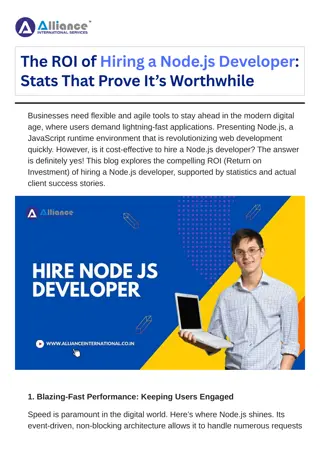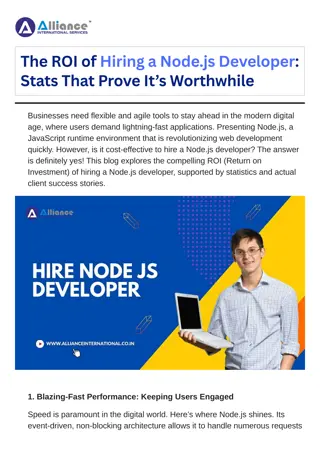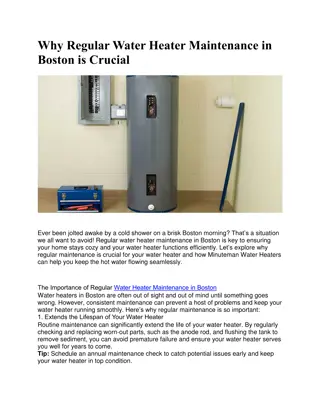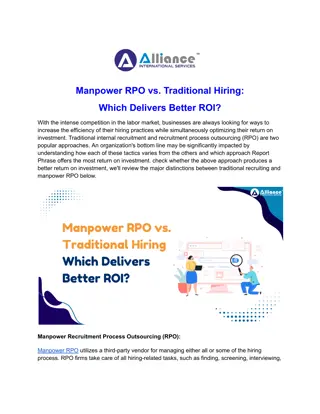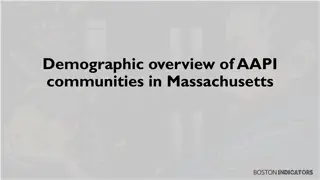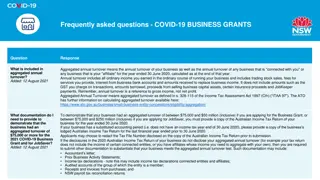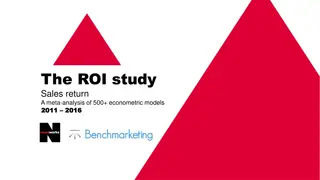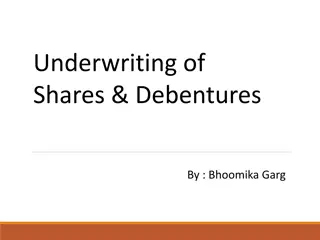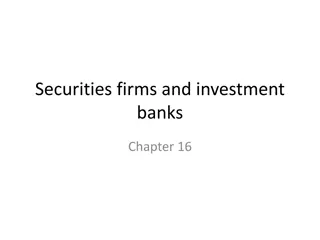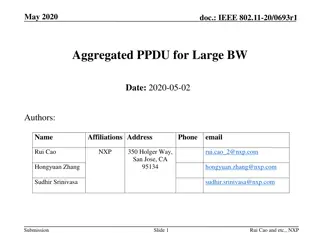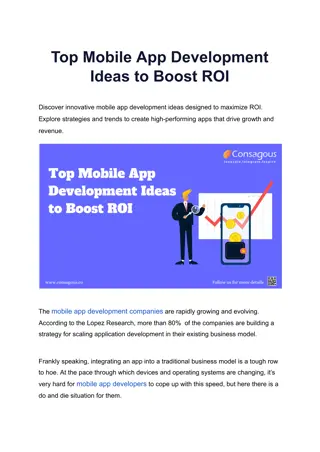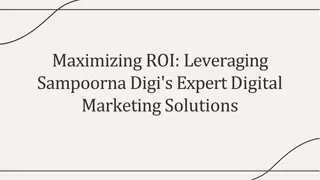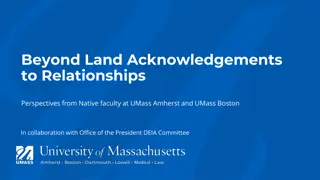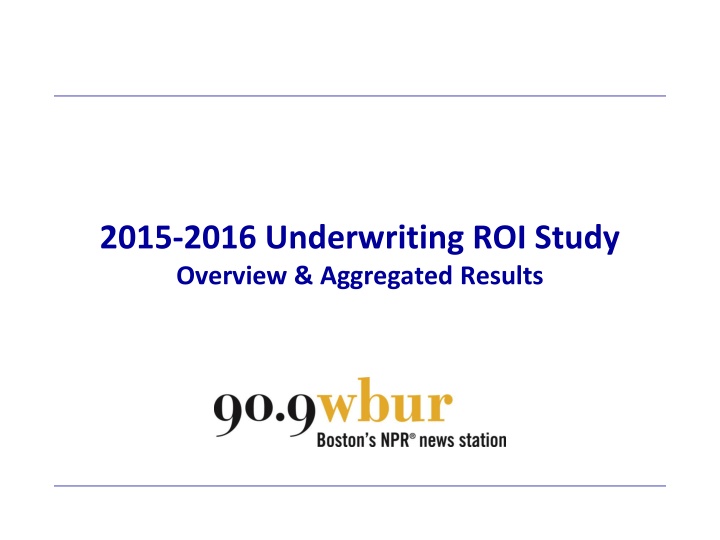
Study on Public Radio Sponsorship Effectiveness in Underwriting ROI
Conducted between 2015 and 2016, this study examines the effectiveness of public radio sponsorship messages underwritten by WBUR Boston. The research compares underwriting on local public radio against traditional commercial media outlets, measuring changes in metrics such as usage, purchase consideration, and perceptions of quality. Various companies and organizations in different product and service categories participated as sponsors, providing valuable insights into the impact of public radio sponsorship.
Download Presentation

Please find below an Image/Link to download the presentation.
The content on the website is provided AS IS for your information and personal use only. It may not be sold, licensed, or shared on other websites without obtaining consent from the author. If you encounter any issues during the download, it is possible that the publisher has removed the file from their server.
You are allowed to download the files provided on this website for personal or commercial use, subject to the condition that they are used lawfully. All files are the property of their respective owners.
The content on the website is provided AS IS for your information and personal use only. It may not be sold, licensed, or shared on other websites without obtaining consent from the author.
E N D
Presentation Transcript
2015-2016 Underwriting ROI Study Overview & Aggregated Results
Survey Background and Methodology WBUR invested in an ROI study to measure the effectiveness of public radio sponsorship messages. The study was underwritten by WBUR Boston and is similar to the ROI research completed by WBUR in 2011 and 2012. The first wave of the study was completed in August 2015 and the second wave was completed in January 2016. Survey respondents were recruited online from the Lightspeed Research consumer panel. The sample size across both waves of the study is 3,000 adults between the ages of 25 and 64 spread across five public radio markets (Boston, Denver, San Francisco, Seattle and Washington). Weights are applied to the samples in each market to set the local station listeners in proportion to the actual listener reach while aligning listener, nonlistener and total market demographics to benchmark norms from the Census Bureau. Unlike many media studies of this kind, this study has been designed to measure specifically how underwriting a nontraditional marketing message on local public radio compares directly against traditional commercial media outlets (other radio stations, local TV stations, local print publications and website audiences.) Q4 2015 Public Radio Underwriting ROI Study 2
Survey Background and Methodology Research has been conducted to measure changes in one or more of the following metrics among companies and organizations: Current usage or recent purchases Consideration for next/ future purchase Perceptions of quality or overall reputation These metrics were measured before and after the Q4 2015 sponsorship period among local public radio station listeners as well as among consumers found in these competing media placement channels: Leading commercial radio stations (top 10 in each market) Local broadcast TV network affiliates and local news channels Leading print publications serving the local market Leading digital properties including top local sites Q4 2015 Public Radio Underwriting ROI Study 3
Survey Background and Methodology The research includes companies and organizations in several leading product and service categories that support public radio in the markets covered by the study. Companies and organizations within each of these categories are classified as new public radio sponsors, continuing public radio sponsors and prospective sponsors. Forty (40) different companies and organizations began sponsoring their local public radio station in Q4 2015. Sixty-three (63) different companies and organizations continued sponsoring their local public radio station in Q4 2015. Product and Service Categories: Financial Institutions: Banks Insurance Companies Hospitals University Programs Consumer Products and Services: Sporting Goods Kitchen and Bath Retailers Automobile Manufacturers Automobile Dealerships Home Furnishings Retailers Grocery Stores Coffee Home Security Automobile Service/ Tires Tour Companies Real Estate Agencies Q4 2015 Public Radio Underwriting ROI Study 4
Influences on Willingness to Consider a Company In addition to independent reviews and general support for public radio, public radio listeners are more likely than nonlisteners to be influenced by basic factual messages about a company or product and encouragement to learn more on the web. 52% Independent reviews or awards (such as Consumer Reports or JD Power) 34% 42% Basic facts about the unique features of a company or product without embellishment 32% 26% Support for public radio 10% 20% A message on public radio encouraging you to learn more on the web Public radio listeners 11% Nonlisteners Q: In general, which of the following things influence your willingness to consider doing business with a different company or brand? Base: Consumers age 25-64 surveyed in January 2016 from the five markets covered by the study (n=1,513) Q4 2015 Public Radio Underwriting ROI Study 6
Norms for Purchase or Use On average, public radio listeners are more likely than nonlisteners to purchase from or do business with companies that sponsor their local station. Companies that begin sponsoring public radio on average see a 23% gain in market share among public radio listeners after one quarter of sponsorship. Purchases from/ Use of Companies that Consistently Sponsor Public Radio1 Purchase from/ Use of Companies that Begin Sponsoring Public Radio2 (Among Public Radio Listeners) 14% 14% +27% Advantage 12.4% +23% Increase 12% 12% 10.1% 10% 10% 8.2% 8% 8% 6.4% 6% 6% 4% 4% 2% 2% 0% 0% Among Public Radio Listeners Among Nonlisteners Before campaign (wave 1) After campaign (wave 2) 1 Data compiled by from the average purchase or usage scores for 43 continuing public radio sponsors in all categories 2 Data compiled from the average purchase or usage scores for 29 new public radio sponsors starting a campaign in Q4 2015 after not being on air in the preceding quarter. Q4 2015 Public Radio Underwriting ROI Study 8
Norms for Purchase or Use, by Category On average, public radio listeners are 14% more likely than nonlisteners to purchase from or do business with nontraditional sponsors of public radio. Consumer product and service companies that begin sponsoring public radio on average see a 37% gain in business from public radio listeners after one quarter. Purchase from/ Use of Companies that Begin Sponsoring Public Radio2 (Among Public Radio Listeners) Before campaign (wave 1) Purchases from/ Use of Companies that Consistently Sponsor Public Radio1 After campaign (wave 2) Among Public Radio Listeners Among Nonlisteners 18% 18% 15.8% 16% 16% +37% 14% 14% 11.6% 11.6% 10.9% 12% 12% 9.2% +6% 10% 10% 8.1% 7.9% 7.3% 7.0% 8% 8% +14% 5.7% 5.3% +49% 4.9% 6% 6% +47% +24% 4% 4% 2% 2% 0% 0% Banking/ Insurance (Hold account or policy) Consumer Products and Services (Purchase) University Programs (Express interest) Banking/ Insurance (Hold account or policy) Consumer Products and Services (Purchase) University Programs (Express interest) 1 Data compiled by from the average purchase or usage scores for 43 continuing public radio sponsors in all categories 2 Data compiled from the average purchase or usage scores for 29 new public radio sponsors starting a campaign in Q4 2015 after not being on air in the preceding quarter. Q4 2015 Public Radio Underwriting ROI Study 9
Norms for Consideration On average, companies that consistently sponsor public radio are 31% more likely to be considered for future purchases by listeners compared to nonlisteners. Consideration of Companies that Consistently Sponsor Public Radio1 25% 21% 20% +31% Advantage 16% 15% 10% 5% 0% Among Public Radio Listeners Among Nonlisteners 1 Data compiled by from the average consideration scores for 52 continuing public radio sponsors in all categories Q4 2015 Public Radio Underwriting ROI Study 10
Norms for Consideration, by Category On average, non-traditional companies that consistently sponsor public radio are 39% more likely to be considered for future purchases by listeners of public radio. Consideration of Companies that Consistently Sponsor Public Radio1 Among Public Radio Listeners Among Nonlisteners 28% 24% +19% 23% 19% +45% 16% 14% 14% +39% 12% +19% Banking/ Insurance (Accounts, services, policies) Consumer Products and Services (Purchase) Hospitals (for non- emergency care) University Programs (Express interest) 1 Data compiled by from the average consideration scores for 52 continuing public radio sponsors in all categories Q4 2015 Public Radio Underwriting ROI Study 11
Norms for Perceived Quality & Reputation Companies that consistently sponsor public radio are more likely to be perceived by listeners as having the best reputation or offering the highest quality. Companies that begin sponsoring public on average see a small gain in perceived quality after one quarter of sponsorship. Perceived Quality of Companies that Consistently Sponsor Public Radio1 +19% Advantage Perceived Quality of Companies that Begin Sponsoring Public Radio2 (Among Public Radio Listeners) 30% 30% 28% +7% Increase 24% 24% 25% 25% 22% 20% 20% 15% 15% 10% 10% 5% 5% 0% 0% Before campaign (wave 1) After campaign (wave 2) Among Public Radio Listeners Among Nonlisteners 1 Data compiled by from the average quality perception scores for 47 continuing public radio sponsors in all categories 2 Data compiled from the average quality perception scores for 25 new public radio sponsors starting a campaign in Q4 2015 after not being on air in the preceding quarter. Q4 2015 Public Radio Underwriting ROI Study 12
Norms for Perceived Quality, by Category Non-traditional companies that consistently sponsor public radio are more 38% likely to be perceived by listeners as offering high quality products and services. Non-traditional underwriters that begin sponsoring public radio on average see a 9% gain in perceived quality after one quarter of sponsorship. Perceived Quality of Companies that Begin Sponsoring Public Radio2 (Among Public Radio Listeners) Perceived Quality of Companies that Consistently Sponsor Public Radio1 Before campaign (wave 1) After campaign (wave 2) Among Public Radio Listeners Among Nonlisteners 40% 40% 34% 33% 35% 35% 31% 29% +12% +15% 27% 30% 30% 26% 25% 25% 25% 25% 21% +9% 19% 19% 20% 20% +12% 14% +38% 15% 15% 10% 10% 5% 5% 0% 0% Consumer products and services (Quality offered) Hospitals (Quality of care) University Programs (Reputation) Consumer products and services (Quality offered) Hospitals (Quality of care) University Programs (Reputation) 1 Data compiled by from the average quality perception scores for 47 continuing public radio sponsors in all categories 2 Data compiled from the average quality perception scores for 25 new public radio sponsors starting a campaign in Q4 2015 after not being on air in the preceding quarter. Q4 2015 Public Radio Underwriting ROI Study 13
Indexed Values Companies that support public radio on average index 30% to 40% above the wider markets they serve. Index Scores for Public Radio Underwriters Index 100=Value for All Consumers Age 25-64 Public radio listeners Nonlisteners 160 140 131 140 129 120 96 96 94 100 80 60 40 20 0 Recent purchase or current use (1) Would consider for purchase or use (2) Highest quality/ Best reputation (3) 1 Data compiled by from the average purchase or usage scores for 72 new and continuing public radio sponsors in all categories 2 Data compiled by from the average consideration scores for 86 new and continuing public radio sponsors in all categories 3 Data compiled by from the average quality and reputation scores for 73 new and continuing public radio sponsors in all categories Base: Consumers age 25-64 surveyed from the five markets covered by the study (n=3,034) Q4 2015 Public Radio Underwriting ROI Study 15
Media Audience Comparison Underwriters of local public radio index on average about 40% above the wider markets they serve in terms of customer incidence. Recent Purchase or Current Use Index 100=Value for All Consumers Age 25-64 160 140 140 119 120 105 100 98 100 80 60 40 20 0 Public Radio Listeners Listen to Top Commercial Radio Stations Watch Local TV Stations Read Local Newspapers Visit Leading Competitive Websites and Magazines 1 Data compiled by from the average purchase or usage scores for 72 new and continuing public radio sponsors in all categories Base: Consumers age 25-64 surveyed from the five markets covered by the study (n=3,034) Q4 2015 Public Radio Underwriting ROI Study 16
Media Audience Comparison Underwriters of local public radio index on average about 31% above the wider markets they serve in terms of consideration for purchases or use. Would Consider for Purchase or Use Index 100=Value for All Consumers Age 25-64 140 131 120 111 103 100 99 100 80 60 40 20 0 Public Radio Listeners Listen to Top Commercial Radio Stations Watch Local TV Stations Read Local Newspapers Visit Leading Competitive Websites and Magazines Data compiled by from the average consideration scores for 85 new and continuing public radio sponsors in all categories Base: Consumers age 25-64 surveyed from the five markets covered by the study (n=3,034) Q4 2015 Public Radio Underwriting ROI Study 17
Media Audience Comparison Underwriters of local public radio index on average about 29% above the wider markets they serve in terms of the perceived quality or reputation of the company. Offers the Highest Quality or Has Best Reputation Index 100=Value for All Consumers Age 25-64 140 129 120 106 101 100 98 100 80 60 40 20 0 Public Radio Listeners Listen to Top Commercial Radio Stations Watch Local TV Stations Read Local Newspapers Visit Leading Competitive Websites and Magazines Data compiled by from the average quality and reputation scores for 72 new and continuing public radio sponsors in all categories Base: Consumers age 25-64 surveyed from the five markets covered by the study (n=3,034) Q4 2015 Public Radio Underwriting ROI Study 18
Conclusions Underwriting is Part of the Base Buy in Your Media Mix Becoming a station underwriter is more than just good public relations. Public radio sponsorship is able to generate improvements in self-reported purchase and transactional activity, consideration for future purchases or use and improved perceptions of the quality or reputation of a company or organization. While results vary by market, product/service category and message of the individual sponsor, many sponsors have seen immediate impacts during the first quarter of sponsorship. However, continuing sponsors who support their local station consistently over the long term are able to build upon and maintain significantly higher than average index levels for recent purchase behavior, consideration and perceptions of quality. In addition to traditional sponsors of public radio such as universities, health care institutions and financial institutions, this research shows that public radio sponsorship can be just as effective, if not more so, for companies selling all kinds of products and services to consumers. Q4 2015 Public Radio Underwriting ROI Study 19
Attribution/ Contact Information Corey Lewis, Station Manager clewis@wbur.org (617) 358-2339 Andrew Richardson, Lead Analyst drew@lucidityresearch.com (410) 848-1641 Q4 2015 Public Radio Underwriting ROI Study 20


